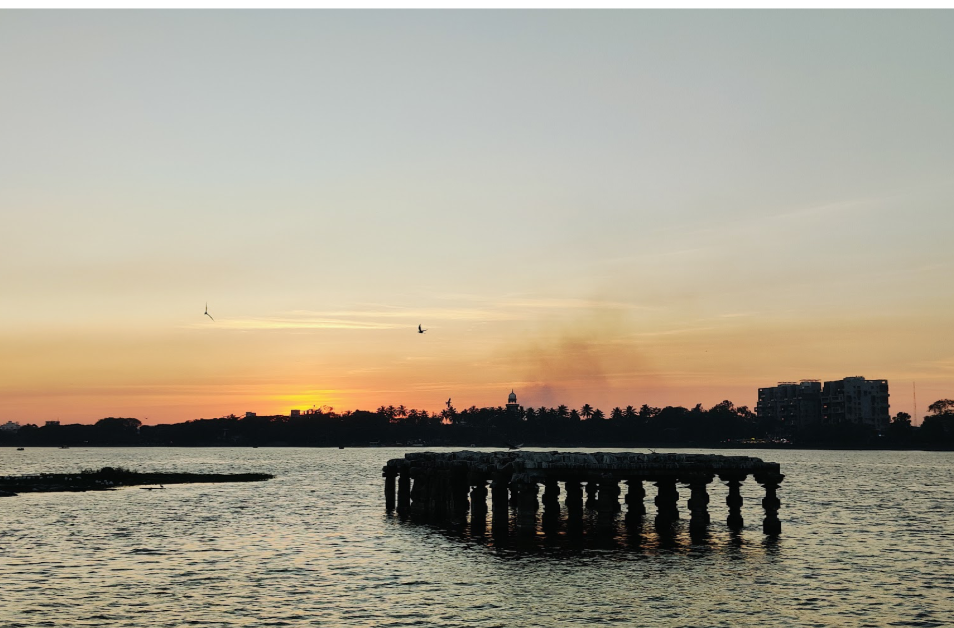KOLHAPUR
Stories
Last updated on 5 November 2025. Help us improve the information on this page by clicking on suggest edits or writing to us.
Where does the name “Kolhapur” come from?
The name Kolhapur comes from the demon Kolhasur. The local Devi in Kolhapur is known as Kolhasurmardini, also known as Shri Ambabai. According to locals, Brahma’s sons Gaya, Lavanasur, and Kolhasur performed penance and obtained powers. Gaya and Lavana were defeated by the devtas; however, Kolhasur remained hidden. He came to the Deccan plateau city of Karveer, where he appointed his four sons in four directions to guard against devtas while he continued his penance.
Pleased with his devotion, the Devi granted Kolhasur a boon: she would leave Karveer for 100 years, allowing him to reign unchallenged. The Devi retreated to the Himalayas, and during her absence, Kolhasur and his sons ruled with terror, causing suffering among humans and animals alike.
When 100 years had passed, the Devi awakened. She mounted a mighty lion, wielding lethal weapons in her 18 hands. As she approached the city, she was welcomed by its residents. A fierce battle ensued, culminating in the Devi beheading Kolhasur. Before dying, Kolhasur requested that his name be associated with the city of his death and that it become a Teertha. The Devi consented, declaring that Karveer would henceforth be called Kolhapur and known as Dakshin Kashi.
Rankala Lake

Some believe that Devi Shree Ambabai created it with her Gadha (mace), while others suggest it formed due to an earthquake that caused water accumulation. Beneath the lake lies a mandir dedicated to Devta Rankabhairav, which remains unseen; it is said that when the lake dries, the mandir will be revealed.
The Sandhyamath, located at the lake's edge, has its own story. According to locals, asuras attempted to construct it but fled upon realizing that sunrise was approaching, leaving it without a roof. Residents later established a Ganesh murti along with Mahadev pind and Nandi.
Jyotiba Mandir
![Jyotiba Mandir[1]](/media/culture/images/maharashtra/kolhapur/stories/jyotiba-mandir1-c0d2a587.png)
The Jyotiba Mandir, also known as Wadi Ratnagiri, was initially a small mandir before being rebuilt by Ranojirao Shinde of Gwalior in 1730. The mandir houses a four-and-a-half-foot idol of Jyotiba with four blue hands facing south. This orientation symbolizes Jyotiba's vow to protect Devi Ambabai after defeating the asura Ratnasur.
The chant "Changabhala," commemorates Jyotiba's victories over asuras who troubled the devtas. The region was historically known as Vaitagwadi before being named Ratnagiri after Ratnasuri.
Kolhapur Mahalaxmi Mandir
The Kolhapur Mahalaxmi Mandir is one of the Shaktipeeths mentioned in the Hindu Puranas and is located on the banks of the Panchganga River. The devi worshipped here is known as Mahalaxmi or Ambabai.
According to a tale, Sage Bhrigu visited Vaikuntha to meet Vishnu but was ignored while Vishnu rested. Angered by this perceived slight, Bhrigu attacked Vishnu by kicking him in the chest, but Vishnu responded calmly and hospitably instead. Devi Laxmi, angered and dismayed by her husband's response to this incident, left Vaikuntha for earth and chose Kolhapur as her new abode. It is believed that aashirwad from Devi Mahalaxmi is incomplete without that from Tirupati; thus, a silk saree is sent from Tirupati every year for her during Dussehra.
Datta Maharaj Bhojan Patra Mandir
Shri Datta Maharaj Bhojan Patra Mandir is situated in Shirol taluka of Kolhapur District. Dutt Maharaj lived in Shirol for a long time; this place is called Devbhumi. Many people visit Narsobachi Wadi in Shirol to see Datta Guru.
This mandir is 6 km from Narsobachi Wadi. It is mentioned in the Gurucharitra of Datta Purana that Dattaguru went to the house of a Brahmin named Gangadhar to ask for food. Gangadhar’s wife welcomed him and gave him water to wash his feet, but she only had 'jondhala' (sorghum or jawar) to cook. She was confused about what to do.
Seeing her confusion, Dutt Maharaj picked up a stone from the door, cleaned it, and told her to cook the seeds on it. She followed his instructions and cooked the seeds on the stone. Maharaj ate happily; as he touched the stone, marks resembling his fingers and symbols like chakra appeared on it.
After eating, Maharaj disappeared. The marks are still visible on the stone when milk is poured over it, a ritual observed since 1364, continues today. The Bhojan Patra Mandir is special; many people visit it to see the marks left by Dutt Maharaj.
Vithaal Birdev Mandir
The Vithaal Birdev Mandir in Pattankodoli has an intriguing origin story involving Vishnu (Vithaal) and Shiva (Birdev). They decided to build a mandir where their respective vehicles, a horse and an eagle, stopped. After obtaining permission from village deity Shree Kalleshwar, they built their mandir under the condition that no sound from drums played at Vithaal Birdev Mandir would disturb Kalleshwar’s meditation.
Last updated on 5 November 2025. Help us improve the information on this page by clicking on suggest edits or writing to us.